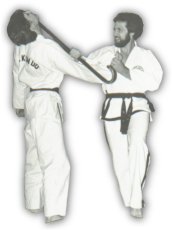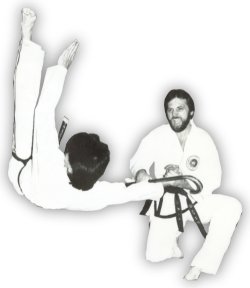History of the Korean Ji Pang E (Cane)
It was almost sunset as Jong Shim made his way down the
narrow street toward his home. Suddenly three men appeared
in front of him and demanded his money. The bandits could
see this was a man of wealth and their efforts were going to
be well rewarded. So when Jong refused to give them his
valuables they rushed in to teach time a lesson. However, it
was the bandits who were about to receive their first lesson
in the use of the deadly Korean Ji Pang E (cane).
 The first bandit's head snapped backward from a blow that
was delivered so fast he never saw it coming. The second
bandit charged forward attempting to crush Jong's head with a
staff. But the staff never found its target, and the bandit
felt a hard jolt and a piercing pain in his back as the ji
pang e struck a hyel do (vital point). The man dropped to
his knees helpless, unable to move his legs. The third
bandit drew his knife and thrust it toward Jong's stomach.
The bandit saw the knife go sailing through the air just a
split second before he found himself airborne. A moment
later he found himself in a crumpled heap on the ground next
to his friends.
The first bandit's head snapped backward from a blow that
was delivered so fast he never saw it coming. The second
bandit charged forward attempting to crush Jong's head with a
staff. But the staff never found its target, and the bandit
felt a hard jolt and a piercing pain in his back as the ji
pang e struck a hyel do (vital point). The man dropped to
his knees helpless, unable to move his legs. The third
bandit drew his knife and thrust it toward Jong's stomach.
The bandit saw the knife go sailing through the air just a
split second before he found himself airborne. A moment
later he found himself in a crumpled heap on the ground next
to his friends.
The confrontation was over in just a few seconds, and Jong
was unhurt as he stood looking at the bandits sprawled on the
ground. They were unconsciousness and completely at Jong's
mercy.
As the first man regained consciousness, he saw Jong bent
over one of the other bandits. Jong was applying healing
pressure to the man's back, and soon the man was able to move
his legs again. Jong methodically went from one bandit to
another until each was able to stand on their own. The
bandits, puzzled but grateful by this act of kindness,
quickly left, more knowledgeable men. They had learned what
an effective weapon the Korean cane could be in the hands of
an expert like Jong Shim. Only much later did they discover
Jong was an instructor of martial arts for the guards of the
royal family of the Korean Kingdom of Silla.
In Today's society it is against the law to carry almost
any type of object which may be deemed as a weapon. The cane
may very well be one of the last "permissible" weapons
available which you can carry to defend yourself without
violating the law. Fortunately, the cane is easy to learn,
versatile and an extremely effective weapon for self-defense.
The use of the cane in not uncommon to other mu do (martial
arts). Many of the Korean martial arts include some
instruction in the use of the ji pang e for self-defense. To
see how the cane was used as a defensive weapon in ancient
times, let's take a look at its evolution in Korea.
Korean monks sometimes carried the cane during their travels.
The cane served them in several different ways; it was used
to help them maintain their balance climbing hills and over
rough terrain, and it was also used to help the monks defend
themselves from bandits and wild animals during their travels
throughout the country. Some Buddhist temples had animals
they raised, and the monks would used their canes to help
oversee their herds and flocks. If the temple was attacked,
the cane could quickly become a defensive weapon, used to
drive the invaders off.

Types Of Canes
There are primarily three different types of canes. The
first type was from five and one-half to seven feet in length
and curved like a hook at one end, similar to the canes
carried by shepherds. The second type of cane was about
waist-high, straight, with either a knob or short straight
handle. The third type of cane is the type most commonly
used both in the past and today. It is about waist-high,
straight and has a curved (hook-type) end used as the handle.
The common people favored it for its practicality.
The Shepherd's Cane
There are primarily three different types of canes. The
first type was from five and one-half to seven feet in length
and curved like a hook at one end, similar to the canes
carried by shepherds. The curved portion of the cane was
quite often used for the application of kwan jyel sul (joint
manipulation techniques). This was the type of cane the
monks used for herding
animals and sometimes as a walking pole on their travels.
Sometimes, in order to escape from bandits, a monk would use
the curved portion of this long version of the cane, to hook
a high branch of a tree, climb up the cane to the branch,
then pull the cane up with him. This another example of how
certain monks got the reputation of being able to become
invisible. The monk could remain hidden in the tree until
the bandits had moved on. If it became necessary, he could
use the cane to strike the bandits as they passed under the
tree, or he could use the hook portion of the cane to pull
them off of their horses. When the encounter was over the
monk would again hook the cane to the branch, climb down,
then continue on his way.
Another favorite tactic the monks used was to hook the top of
a high wall with the ji pang e, then pull themselves to the
top of the wall and over. A perfect example of how they
could "walk through walls".
The Aristocrat's Cane
The second type of cane was about waist-high, straight, with
either a knob or short straight handle. This type of cane
was not as popular with the monks because it was not as
practical for their needs. However, the straight cane was
used very often by the hwa rang, members of the upper
classes, and members of the royal families.
The cane became not only a sign of importance and wealth, but
a deadly weapon for self-defense. Many times the handle bore
the crest of the family, and was made of gold or silver with
jewels embedded in it. In some cases a blade was concealed
in the cane. A sharp pull on the handle and the blade would
be ready for action. For the upper classes the straight cane
was what suited their needs for both appearance and self-
protection.
During the sixth century, Korea was divided into three
separate Kingdoms; Koguryo, the largest of the three, was in
the north, Baek-Je, the second largest was located in the
southwest portion of the Korean peninsula; and Silla, the
smallest of the three Kingdoms, was in the southeast. It was
in the Kingdom of Silla where a group of young warriors
called the Hwa Rang (flowering youths) were created. The hwa
rang were instructed in several different forms of defense
were also part of Buldo mu do (Buddhist
martial arts); kwan jyel sul (joint manipulation), hyel do
sul (striking vital points of the body), and ji pang e sul
(cane techniques). They were instructed in the use of the
cane by Korean monks including the famous Won Kang. As part
of their specialized training, the hwa rang trained in the
application of techniques using the cane for striking,
throwing, controlling, and the application of kwan jyel
defenses. They also carried the cane as a sign of their
social position and status.
The Everyday Cane
The third type of cane is the type most commonly used both in
the past and today. It is about waist-high, straight and has
a curved (hook-type) end used as the handle. The common
people favored it for its practicality. Korean Buddhist
monks also used this type of cane for self-defense because
the hooked portion aided them in the application of kwan jyel
techniques, allowing for better control of an opponent
without the use of excessive force.
Today the cane may be used as a means to defend yourself.
You need not use an excessive amount of force to subdue an
opponent, you can use kwan jyel techniques to immobilize the
opponent by using the cane to help augment the techniques.
The elderly can use kwan jyel techniques with a cane for
self-defense with very little training.
The cane, combined with kwan jyel techniques, is one of the
most practical and useful tools for self-defense you may find
today. Be sure to use extreme caution when working with cane
techniques. You will be able to exert much more power than
you believe you can when you use the leverage of the cane to
give added strength to your techniques. Always let your
instructor guide you each step of the way with your training.
The following techniques are from Grand Master Benko's book: "Korean Cane Techniques (Ji Pang E Sul)" .
The technqiues are performed by Master James A. Benko, Master Gregory Westphal, and Master Philip Curell.